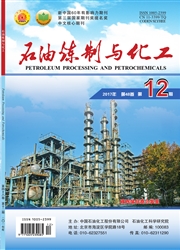

 中文摘要:
中文摘要:
采用选择性氧化法对FCC汽油进行脱硫,以四丁基溴化铵为相转移剂,双氧水为氧化剂,乙酸酐为助氧化剂,考察了反应时间、反应温度、相转移剂用量等工艺条件对脱硫效果的影响。结果表明,当汽油与氧化体系体积比为1:5,双氧水与乙酸酐体积比为1:1,四丁基溴化铵质量为0.02g时,室温下反应0.5h,FCC汽油的脱硫率可达92.10%,汽油收率为90.3%;通过GC-FPD分析得出,含硫化合物被明显脱除。
 英文摘要:
英文摘要:
A selective oxidation process for desulfurization of cracked naphtha was introduced by using tetrabutyl-ammonium bromide as phase transfer catalyst, hydrogen peroxide as oxidant and acetic anhydride as co-oxidant. The effects of reaction time, reaction temperature and the amount of phase transfer catalyst on the desulfurization results were investigated in the laboratory. The test results showed that at room-temperature under the conditions of a reaction time of 0. 5 h, a phase transfer catalyst dosage of 0.02 g, the volume ratios of naphtha to oxidative system and hydrogen peroxide to acetic anhydride were 0.2 and 1, respectively, the desulfurization rate of FCC naphtha was 92.10% with a treated naphtha yield of 90.3 %. The sulfur-containing compounds were removed obviously from the results of GC-FPD analysis.
 同期刊论文项目
同期刊论文项目
 同项目期刊论文
同项目期刊论文
 期刊信息
期刊信息
